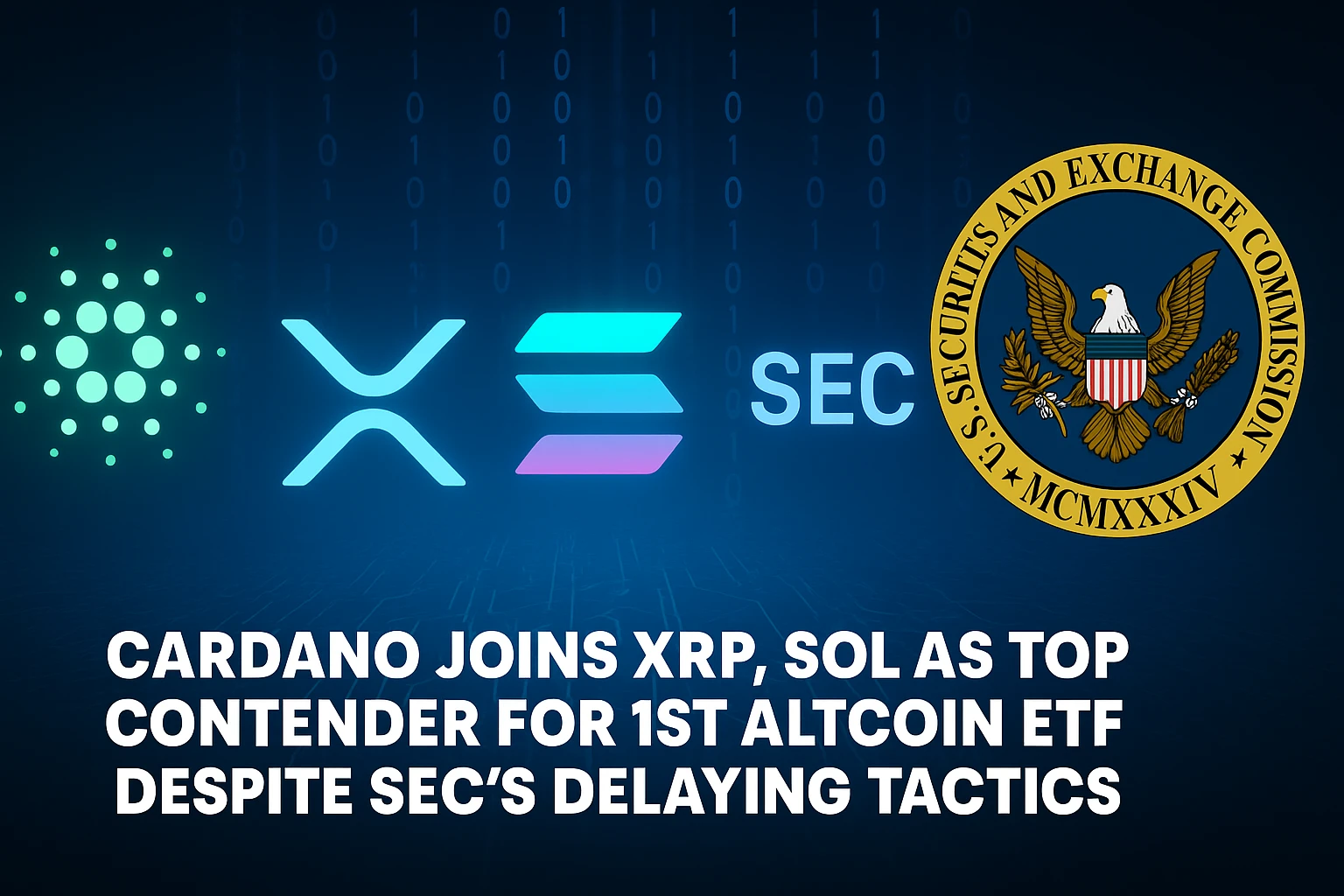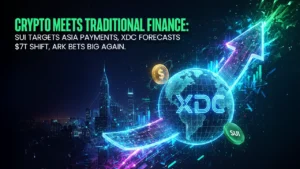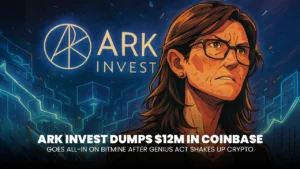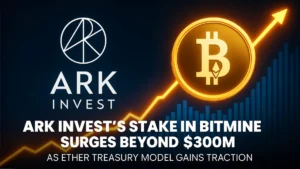Cardano Joins XRP, SOL as Top Contender for 1st Altcoin ETF Despite SEC’s Delaying Tactics

US regulators are edging toward a broader framework for crypto ETFs beyond Bitcoin and Ether. Several reports this week highlighted rising odds that the next wave could include Solana, XRP, and Cardano, with Cardano increasingly cited as a frontrunner on liquidity, derivatives depth, and maturing on-chain governance.
- What Changed This Week For Cardano
- Cardano ETF Filing Timeline
- Market Reaction And Liquidity Considerations
- How A Cardano ETF Would Be Structured
- Selected Cardano Network Metrics (Q1 2025, Messari)
- Regulatory And Institutional Context
- Community And Market Commentary
- Long‑Term Implications If A Cardano ETF Is Approved
- Conclusion
- Frequently Asked Questions for Cardano ETF
- What exactly did the SEC do with the Cardano ETF filing?
- Will a Cardano ETF include on‑chain staking rewards?
- Why is Cardano viewed as a leading candidate among altcoins?
- How does Cardano differ from Delegated Proof of Stake networks?
- What are the main risks for an ADA ETF?
- Glossary of Key Terms
As a blockchain that utilizes Delegated Proof of Stake (DPoS), Cardano provides a model where efficiency and scalability are enhanced by community-driven validator delegation, further strengthening its case for institutional adoption. Coverage from CryptoDnes, Coindoo, and AInvest converges on the same directional takeaway: the question is shifting from if to which assets get first approval
Against that backdrop, the US SEC last month extended its review of Grayscale’s proposed Cardano ETF from late August to October 26, 2025, adding another checkpoint to a fast‑evolving calendar. The delay follows earlier procedural steps in February and May that acknowledged filings and reset clocks. Markets treated the extension as expected, not fatal.
The regulatory tone also matters. Reuters reported in July that the SEC issued new disclosure guidance for crypto ETFs, a first step toward more standardized filings that could shorten reviews, increase transparency on custody and risks, and pave the way for additional products. That broad policy shift frames the Cardano conversation for institutional allocators weighing structure, surveillance, and market‑of‑significant‑size criteria.
ALSO READ: TRON Takes the Lead as US Economic Data Makes Debut on Public Blockchains
What Changed This Week For Cardano
The week’s core development is clarity on the review timeline rather than a yes or no. Grayscale’s Cardano product sits in a queue that regulators are actively managing, and the latest extension aligns with a pattern seen across altcoin proposals. Coverage across Blockonomi and AInvest places the new deadline on October 26, 2025. CoinDesk’s markets desk noted that ADA prices held firm on the news, underscoring that investors had largely priced in the delay.
Meanwhile, analyst commentary continues to highlight Cardano as one of the few assets with both liquidity and derivatives markets to support ETF operations, alongside XRP and Solana. Coindoo and CryptoDnes emphasize this criterion, referencing Bloomberg ETF watchers who say several assets already meet listing thresholds.
Cardano ETF Filing Timeline
| Date | Event |
| Feb 10, 2025 | NYSE Arca files 19b‑4 to list Grayscale Cardano ETF |
| Feb 24, 2025 | SEC formally acknowledges the filing (public tracker and industry commentary) |
| May 29, 2025 | SEC delays Avalanche and Cardano ETF decisions to July 15 |
| Aug 26, 2025 | SEC extends Cardano decision deadline to Oct 26, 2025 |
| Sep 7–8, 2025 | Analysts reiterate that altcoin ETFs are likely led by Solana, XRP, and Cardano |
Market Reaction And Liquidity Considerations
Cardano’s spot price resilience around the deadline shift reflects a market focused on macro flows and the growing probability of altcoin ETFs rather than any single calendar date. CoinDesk reported ADA strength despite the delay, while Decrypt and CryptoNews tracked a rising pile of crypto ETF applications across issuers, implying a busy pipeline that could lift attention and volume across several tickers.
Issuers will still need to show sufficient surveillance‑sharing and liquidity. For Bitcoin and Ether, CME futures were crucial reference points. Altcoins, such as Cardano, do not yet have similar US-regulated futures depth, which keeps the focus on spot market quality, exchange selection, and index methodology.
The Reuters guidance story underscores that the SEC is now standardizing how issuers disclose crypto‑specific risks, custody, and structure, which could help compensate for missing futures benchmarks by improving comparability across filings.
Ethereum ETFs launched in 2024 without staking, and early inflows lagged expectations, suggesting structure matters. Cardano ETFs would likely launch without staking as well, at least initially, given current norms, which place more emphasis on index accuracy, creation‑redemption mechanics, and spreads at the primary and secondary market level.
How A Cardano ETF Would Be Structured
Public filings and industry reporting point to a conventional commodity‑style spot ETP that holds ADA with a qualified custodian, lists on a national exchange, and tracks an independent index.
Grayscale’s push into single‑asset altcoin ETFs indicates NYSE Arca as the listing venue and Coinbase Custody as the depository for underlying ADA. As with other spot products, creations and redemptions would occur in baskets, and the trust would reflect the coin’s daily market value net of fees.
Several outlets describe Cardano, Solana, and XRP as the most likely first movers because they combine deep spot markets with active derivatives markets offshore. That profile supports market‑maker hedging and helps keep ETF spreads tight, a critical institutional requirement.
ALSO READ: Bravemorning Injects $110M Into TRON Treasury, Expands Equity Stake to 86.6%
Importantly, any staking component is unlikely on day one. CryptoTicker and CryptoDnes stress that Ethereum ETFs launched without staking, and adviser feedback indicated that the lack of yield suppressed early demand. The same design trade‑off would likely apply to a Cardano vehicle until regulators publish explicit guidance.
Selected Cardano Network Metrics (Q1 2025, Messari)
| Metric | Value | Notes |
| ADA price (quarter‑end) | 0.66 USD | Down 22% QoQ |
| Market cap (quarter‑end) | 23.8 B USD | Down 21% QoQ |
| Fees collected (ADA) | 1.4 M ADA | Down 28% QoQ |
| Fees collected (USD) | 1.2 M USD | Down 32% QoQ |
| Average fee | 0.34 ADA ≈ 0.29 USD | Up 27% in USD |
| Average daily transactions | Down 28% QoQ | Lower activity |
| Total stake (USD) | 14.4 B USD | Down 22% QoQ |
| Staking participation | Slight decline < 1% QoQ | Largely stable |
Source: Messari, State of Cardano Q1 2025. (Messari)
Cardano’s recent governance upgrades are another institutional focal point. Industry reporting notes the Chang and Plomin updates, which extended on‑chain governance and delegated representation. That is distinct from DPoS frameworks, where governance and validator selection are often intertwined through direct delegate elections. Issuers will need to explain those differences clearly since risk factors for Delegated Proof of Stake include validator concentration and vote cartels, particularly in smaller quorum systems.
Regulatory And Institutional Context
The SEC’s July guidance on crypto ETF disclosures signals a shift to clearer rules on custody, risk, and operational distinctions. Asset managers expect further steps, such as standardized templates, that could compress review times. That would give issuers more certainty in building creation‑redemption processes for non‑BTC, non‑ETH assets, where surveillance and market linkage are less developed.
Separately, the SEC’s posture toward specific tokens has evolved over the last two years. In 2023 filings, the agency named ADA among tokens it viewed as securities in actions involving centralized exchanges. Cardano’s developer responded publicly at the time, disputing the classification. While litigation and enforcement are outside the ETF process, the history is relevant for disclosure and for how fund lawyers describe asset risks in S‑1s and 19b‑4s.
Analyst expectations vary, but several outlets have relayed Bloomberg ETF watchers’ rising probability estimates for a set of altcoin products in 2025. That is not a statement of approval, yet it is a fair signal of how market participants view the pathway following Bitcoin and Ether. Coindoo, CryptoTicker, and CryptoDnes all reflect that consensus in their latest reports, with Decrypt tracking a backlog of more than 90 crypto ETF filings under SEC review.
Community And Market Commentary
Market structure specialists and ETF analysts continue to post updates on the filings and odds:
Nate Geraci on the SEC’s acknowledgment of NYSE Arca’s 19b‑4 for Grayscale’s Cardano ETF:
SEC *acknowledges* NYSE’s 19b-4 filing to list & trade Grayscale Cardano ETF… pic.twitter.com/fKQ6u9YowH
— Nate Geraci (@NateGeraci) February 24, 2025
Such commentaries often reference the same operational points institutional desks care about: custody segregation, basket sizes, authorized participant readiness, and whether offshore derivatives provide sufficient hedging capacity in the absence of US futures. Where Delegated Proof of Stake networks face questions about validator concentration, Cardano’s stake‑pool model gives lawyers a different set of governance disclosures and avoids the elected‑delegate design standard of DPoS. (Cointelegraph)
Long‑Term Implications If A Cardano ETF Is Approved
A US‑listed spot Cardano ETF would make ADA accessible through brokerage accounts, portfolio management systems, and retirement wrappers. That lowers operational friction for institutions that cannot hold tokens directly. It could also broaden investor profiles, from hedge funds seeking exposure to PoS assets to asset allocators benchmarking non‑BTC crypto beta.
AInvest estimates suggest sizable potential inflows as altcoin ETFs roll out, though realized demand will depend on how issuers handle fee levels, index design, and operational scale without staking yield.
For compliance teams, a Cardano ETF would establish a documented control framework encompassing custody, creation and redemption, audit, and valuation. This may help distinguish Cardano from networks that rely on DPoS, where validator election and concentration can raise unique governance concerns for disclosures.
Over time, the presence of a spot product could improve price discovery, narrow spreads, and provide an additional lens on Cardano’s fee economics and on‑chain activity, as captured in datasets tracked by Messari and CoinDesk.
Conclusion
Based on the news flow and formal regulatory steps, Cardano has moved into the first ring of candidates for a US altcoin spot ETF. The SEC’s extension to October 26, 2025 keeps the file active, not rejected. Analysts across multiple outlets continue to cite ADA’s liquidity profile, derivatives activity, and network maturity as key reasons it remains on short lists, even as demand questions persist in the wake of non-staking Ether ETFs.
Cardano, which uses Delegated Proof of Stake (DPoS) as its consensus mechanism, further strengthens its case with an energy-efficient governance model that is already aligned with institutional preferences for compliance and sustainability. The next checkpoints are regulatory: standardized disclosures, clarity on surveillance and custody, and whether filings can clear without a US futures anchor.
If approval comes, the institutional toolset around Cardano would expand quickly, with portfolio, audit, and compliance benefits that direct token exposure cannot match today.
Frequently Asked Questions for Cardano ETF
What exactly did the SEC do with the Cardano ETF filing?
The SEC extended its review deadline to October 26, 2025, keeping the application in process rather than denying it.
Will a Cardano ETF include on‑chain staking rewards?
Current spot crypto ETFs in the US do not include staking. Reporting around altcoin proposals suggests the same structure is likely at launch.
Why is Cardano viewed as a leading candidate among altcoins?
Analysts highlight ADA’s liquidity, derivatives markets, and governance maturity in comparison to its peers.
How does Cardano differ from Delegated Proof of Stake networks?
Cardano uses Ouroboros proof of stake with stake‑pool delegation, not Delegated Proof of Stake with elected block producers.
What are the main risks for an ADA ETF?
Lack of US futures for hedging, evolving regulation, and uncertain demand without staking are the key risks.
Glossary of Key Terms
- 19b‑4: Exchange rule change filing used to list a new ETF.
- S‑1: Registration statement detailing fund structure, risks, and operations.
- Spot ETF: A Fund that holds the underlying asset directly rather than futures.
- Creation‑Redemption: Primary market process that keeps ETF prices near NAV.
- Custodian: Qualified entity safeguarding the underlying crypto.
- Ouroboros: Cardano’s proof‑of‑stake consensus protocol.
- Delegated Proof of Stake (DPoS): Consensus where tokenholders elect a small set of validators to produce blocks.
- Surveillance‑Sharing: Exchange agreements to monitor and deter manipulation.
- Index Methodology: Rules for selecting price sources and calculating NAV.
Authorized Participant: Institution that creates and redeems ETF shares.




